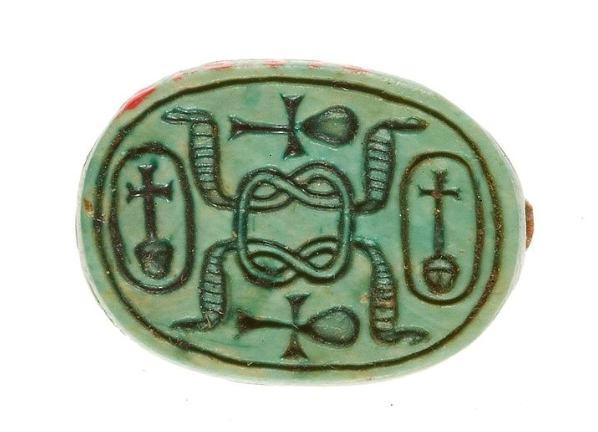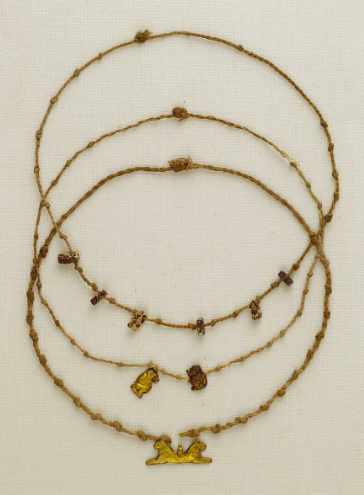JH Reference Library: Modern Antiquities Capsule 01

We are pleased to present The Modern Antiquities Capsule 01, our first jewelry collection in partnership with the Metropolitan Museum of Art.
A trio of rings in the Modern Antiquities Capsule
Scarab Inscribed with a Hieroglyphic Motif
Date: ca. 1479–1458 B.C.
Geography: New Kingdom
(Source: The Met)
Our capsule includes hand-carved quartz cabochons reflective of a knot motif found etched in an ancient scarab — discovered buried in the Temple of Hatshepsut, ca. 2000 B.C.
Symbolic scarab amulets could be found in excess in Ancient Egypt — known as a “motto scarab,” this particular Uraeus Knot design represented the sun god Ra & powerful protection for its wearer.
It was said that Ra transformed into a scarab to bring the sun down to the underworld at night before returning again each morning as a symbol of the rising dawn.
These allegories recast jewelry as containers capable of rich histories — often carrying clandestine meaning beyond aesthetic forms. With this ethos in mind, and thanks to the museum’s curators, our collection layers the quartz talisman through a modern lens with 14k gold, sterling silver, Japanese Akoya pearls, and silk cording —a decadent ode to a bygone era, interpreted through both symbol and material.
Chain terminating in a leaf motif, with a raised openwork clasp ornament
Period: Roman Period
Date: A.D. 2nd century
Geography: Egypt
(Source: The Met)
The Met shared with us that Roman period pendants were most often circular — inspiring our oval Talisman Collar.
We’ve always been drawn to designs which could lovingly be referred to as ‘puffy.’ When the Met introduced us to these ancient Pennanular earrings, we were struck by their modernity and minimalism.
Historically, the circle was a hieroglyphic stand-in for solar forms, and we cannot help but imagine these silver and gold sets as subtle moons & suns.
Pair of Earrings
Period: Second Intermediate Period–Early New Kingdom
Date: ca. 1635–1458 B.C.
Geography: From Egypt, Upper Egypt, Thebes
(Source: The Met)
Pair of Penannular Earrings
Period: Second Intermediate Period–Early New Kingdom
Date: ca. 1635–1458 B.C.
Geography: From Egypt, Upper Egypt/Gold
(Source: The Met)
It is particularly satisfying to find inspiration in more unlikely places. This rope jar sling served as inspiration for our cord necklaces, juxtaposing a more utilitarian element within luxe pendants.
We used satin as opposed to reeds, but the quality of enduring fiber remains.
Above, Rope Jar Sling
Period: Middle Kingdom
Date: ca. 2030–1640 B.C.
Geography: From Egypt, Upper Egypt, Thebes/Medium: Reed rope
(Source: The Met)
Japanese Akoya pearl detail on the Talisman Collar
The tiny token at the clasp of this necklace (showcasing an unusual Figure 8 chain for its time) influenced our addition of a small baroque pearl on the pendants.
Above, Necklace with ornate clasp ornament and a small drop pendant
Period: Roman Period
Date: A.D. 2nd century
Geography: From Egypt
(Source: The Met)
Rope Jar Sling
Period: Middle Kingdom
Date: ca. 2030–1640 B.C
Geography: From Egypt, Upper Egypt, Thebes
Medium: Reed rope
(Source: The Met)
While these necklaces appear simple in form, they hold a metaphor in the making; the 12 knots on these ancient pieces represent 12 hours in the day.
We love this literal ‘tie-in’ that furthers the Sun god’s passage of time.
It is speculated that such necklaces were also crafted specifically for burial — and thus held messages of cyclicality, regeneration, and numbered time.
In conversation with the Met’s curators, we were also introduced to emerging context around the story of Hatshepsut, one of the few—and most successful—women to rule Egypt as pharaoh. She was only the third woman to become pharaoh in 3,000 years of ancient Egyptian history, and was the first to attain the full power of the position.
Hatshepsut’s story has only recently come into a full understanding, rewriting her history with new information detailing her rule — the widowed queen of pharaoh Thutmose II in 1479 B.C., she had been named regent of her five-year-old stepson Thutmose III until he came of age. However, within a few years Hatshepsut declared herself King, and would go on to reign alongside Thutmose III for 22 years until her death in 1458 B.C. Late in his reign, it is believed Thutmose III destroyed the majority of depictions of her as a part of establishing his power.
Such historical realities remind one of the potentialities housed within objects, and the potency of their symbols.
Often carved in contrasts, Hatsheput can be seen also as a two-part sphinx.
Title: Seated Statue of Hatshepsut
Period: New Kingdom
Reign: Joint reign of Hatshepsut and Thutmose III
Date: ca. 1479–1458 B.C.
Geography: From Egypt, Upper Egypt, Thebes
Medium: Indurated limestone, paint
(Source: The Met)
Title: Sphinx of Hatshepsut
Period: New Kingdom
Reign: Joint reign of Hatshepsut and Thutmose III
Date: ca. 1479–1458 B.C.
Geography: From Egypt, Upper Egypt, Thebes
(Source: The Met)
The terraced temple of Hatshepsut (foreground) and the temple of Mentuhotep II at Deir el-Bahri (T 3120). Photograph by Harry Burton, ca. 1912. Archives of the Egyptian Expedition, Department of Egyptian Art.
(Source: The Met)
A procession known as The Beautiful Festival of the Valley which honored the dead would begin at the mortuary temple of Hatshepsut.

















